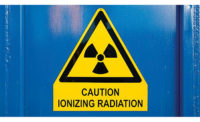What you need to know about ionizing radiation

That “CAUTION IONIZING RADIATION” yellow and black warning sign is intimidating enough to frighten anyone – as though any thought of radiation exposure is enough to us running for SCBAs, chemical suits, and bunkers.
Let’s not get carried away, though. We’re all exposed to natural sources of ionizing radiation on a daily basis, such as soil, water, vegetation, and in human-made sources such as X-rays and medical devices. More than 60 naturally-occurring radioactive materials are found in soil, water and air. Certainly ionizing radiation can cause diseases and death if we are exposed to too much, but ionizing radiation isn’t a risk unless a living organism is exposed to too much.
What's the danger?
Why can ionizing radiation be dangerous? When atoms in living cells become ionized, one of three things usually occurs – the cell dies, the cell repairs itself, of the cell mutates incorrectly and can become cancerous, according to www.physicscentral.com. The cells that reproduce the most and are the least specialized are most likely to be affected by ionizing radiation, for example, those cells that form a fetus. This is why special precautions must be taken for pregnant workers at risk of exposure.
Ionizing radiation sources are found in a range of occupational settings, including healthcare facilities, research institutions, nuclear reactors, and nuclear weapon production facilities, among others. These radiation sources can pose a health risk to workers if not controlled.
According to OSHA’s ionizing radiation standard (1910.1096), no employer can possess, use, or transfer sources of ionizing radiation that causes any individual in a restricted area to receive in any period of one calendar quarter a dose in excess of these limits: whole body (1.25 rems); hands and feet (18.75 rems); and skin of whole body (7.2 rems).
Definitions
A Restricted area is any area controlled by an employer to restrict access and protect individuals from exposure to radiation or radioactive materials.
Rem is a measure of the dose of any ionizing radiation to body tissue in terms of its estimated biological effect relative to a dose of 1 roentgen (r) of X-rays (1 millirem (mrem)=0.001 rem). The average person in the U.S. receives between 100 and 400 millirem (mrem) each year, depending on where they live. Scientists have not reached consensus on the health effects of very low doses of radiation (less than 10 rem). Exposure to doses of 10-50 rem may increase chances of cancer, and will have observable short-term effects on blood cells. Doses between 50-100 rem over a short time have observable effects, and over a long time will increase chances of cancer. Above 100 rem, if the dose is received in a short amount of time, those exposed might experience nausea and will require medical attention. Above 500 rem in a short timeframe exposure may cause death within days.
Evaluation and monitoring
According to OSHA’s ionizing radiation standard, employers must evaluate radiation hazards relating to the production, use, release, disposal, or presence of radioactive materials or other sources of radiation under a specific set of conditions. When appropriate, this evaluation includes a physical survey of the location of materials and equipment, and measurements of levels of radiation or concentrations of radioactive material present. Every employer must supply appropriate personnel monitoring equipment, such as film badges, pocket chambers, pocket dosimeters, or film rings, and must require the use of such equipment by each employee who enters a restricted area under circumstances where he receives, or is likely to receive, a specified dose in any calendar quarter (see OSHA’s standard for specific exposure levels that trigger monitoring). Personnel monitoring equipment are devices designed to be worn or carried by an individual to measure the dose received (film badges, pocket chambers, pocket dosimeters, film rings, etc.).
Radioactive jobs
The average nuclear power plant worker receives less than one-fifth of the radiation exposure of a flight crew on the New York to Tokyo route. High doses of ionizing radiation over a short time are very rare in the nuclear industry due to robust safety protocols.
Mine workers are exposed to radiation from the decay of radon and uranium, but today with greater regulation, testing and ventilation, radiation exposure is up to 1,000 times less than it was in the past.
Radiology technicians working before 1950 have an increased risk of cancer, according to the National Cancer Institute. Since then, risks have been greatly reduced. Most work-related health standards now cap the annual radiation exposure at 5 rem, about 10 times the average background radiation that we receive every year, according to OSHA.
Transportation Security Administration (TSA) baggage screeners have had their radiation exposures evaluated by NIOSH, and NIOSH determined that they were not receiving enough safety training. Doses for some screeners exceeded the maximum dose allowed by law. NIOSH recommended continued monitoring of radiation exposure and improved safety training.
Looking for a reprint of this article?
From high-res PDFs to custom plaques, order your copy today!







